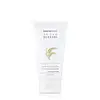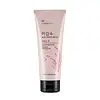Thank You Farmer Rice Pure Clay Mask To Foam Cleanser Versus The Face Shop Rice Water Bright Foaming Cleanser
What's inside
What's inside
 Key Ingredients
Key Ingredients

No key ingredients
 Benefits
Benefits

 Concerns
Concerns

 Ingredients Side-by-side
Ingredients Side-by-side

Water
Skin ConditioningKaolin
AbrasiveSodium Cocoyl Glycinate
CleansingOryza Sativa Extract
AbsorbentGlycerin
HumectantBentonite
AbsorbentMyristic Acid
CleansingPotassium Hydroxide
BufferingLauric Acid
CleansingGlycol Distearate
EmollientTitanium Dioxide
Cosmetic ColorantCentella Asiatica Extract
CleansingFicus Carica Fruit Extract
HumectantAvena Sativa Kernel Extract
AbrasiveAcmella Oleracea Extract
Skin ProtectingCoix Lacryma-Jobi Ma-Yuen Seed Extract
Skin ConditioningCoix Lacryma-Jobi Ma-Yuen Shell Extract
HumectantUlmus Davidiana Root Extract
Skin ConditioningAmaranthus Caudatus Seed Extract
Skin ConditioningChenopodium Quinoa Seed Extract
Skin ConditioningOlea Europaea Fruit Oil
MaskingCoix Lacryma-Jobi Ma-Yuen Seed Water
Skin ConditioningCitrus Aurantium Dulcis Flower Oil
AstringentHydrogenated Lecithin
EmulsifyingMagnesium Aluminum Silicate
AbsorbentPalmitic Acid
EmollientStearic Acid
CleansingButylene Glycol
HumectantDisodium EDTA
Decylene Glycol
Skin ConditioningTorreya Nucifera Seed Oil
EmollientCeramide NP
Skin ConditioningHydroxyacetophenone
AntioxidantEthylhexylglycerin
Skin ConditioningWater, Kaolin, Sodium Cocoyl Glycinate, Oryza Sativa Extract, Glycerin, Bentonite, Myristic Acid, Potassium Hydroxide, Lauric Acid, Glycol Distearate, Titanium Dioxide, Centella Asiatica Extract, Ficus Carica Fruit Extract, Avena Sativa Kernel Extract, Acmella Oleracea Extract, Coix Lacryma-Jobi Ma-Yuen Seed Extract, Coix Lacryma-Jobi Ma-Yuen Shell Extract, Ulmus Davidiana Root Extract, Amaranthus Caudatus Seed Extract, Chenopodium Quinoa Seed Extract, Olea Europaea Fruit Oil, Coix Lacryma-Jobi Ma-Yuen Seed Water, Citrus Aurantium Dulcis Flower Oil, Hydrogenated Lecithin, Magnesium Aluminum Silicate, Palmitic Acid, Stearic Acid, Butylene Glycol, Disodium EDTA, Decylene Glycol, Torreya Nucifera Seed Oil, Ceramide NP, Hydroxyacetophenone, Ethylhexylglycerin
Water
Skin ConditioningMyristic Acid
CleansingGlycerin
HumectantPotassium Hydroxide
BufferingStearic Acid
CleansingGlycol Distearate
EmollientLauric Acid
CleansingCocamidopropyl Betaine
CleansingCocamide Mea
EmulsifyingDisodium Cocoamphodiacetate
CleansingGlyceryl Stearate
EmollientPEG-100 Stearate
Sodium Lauryl Sulfate
CleansingOryza Sativa Extract
AbsorbentSaponaria Officinalis Leaf Extract
AntimicrobialOryza Sativa Bran Oil
EmollientTitanium Dioxide
Cosmetic ColorantSodium Chloride
MaskingDivinyldimethicone/Dimethicone Copolymer
C12-13 Pareth-23
CleansingC12-13 Pareth-3
EmulsifyingHexylene Glycol
EmulsifyingDisodium EDTA
CI 42090
Cosmetic ColorantCI 19140
Cosmetic ColorantCI 14700
Cosmetic ColorantHydroxypropyl Methylcellulose
Emulsion StabilisingParfum
MaskingWater, Myristic Acid, Glycerin, Potassium Hydroxide, Stearic Acid, Glycol Distearate, Lauric Acid, Cocamidopropyl Betaine, Cocamide Mea, Disodium Cocoamphodiacetate, Glyceryl Stearate, PEG-100 Stearate, Sodium Lauryl Sulfate, Oryza Sativa Extract, Saponaria Officinalis Leaf Extract, Oryza Sativa Bran Oil, Titanium Dioxide, Sodium Chloride, Divinyldimethicone/Dimethicone Copolymer, C12-13 Pareth-23, C12-13 Pareth-3, Hexylene Glycol, Disodium EDTA, CI 42090, CI 19140, CI 14700, Hydroxypropyl Methylcellulose, Parfum
 Reviews
Reviews

Ingredients Explained
These ingredients are found in both products.
Ingredients higher up in an ingredient list are typically present in a larger amount.
Disodium EDTA plays a role in making products more stable by aiding other preservatives.
It is a chelating agent, meaning it neutralizes metal ions that may be found in a product.
Disodium EDTA is a salt of edetic acid and is found to be safe in cosmetic ingredients.
Learn more about Disodium EDTAGlycerin is already naturally found in your skin. It helps moisturize and protect your skin.
A study from 2016 found glycerin to be more effective as a humectant than AHAs and hyaluronic acid.
As a humectant, it helps the skin stay hydrated by pulling moisture to your skin. The low molecular weight of glycerin allows it to pull moisture into the deeper layers of your skin.
Hydrated skin improves your skin barrier; Your skin barrier helps protect against irritants and bacteria.
Glycerin has also been found to have antimicrobial and antiviral properties. Due to these properties, glycerin is often used in wound and burn treatments.
In cosmetics, glycerin is usually derived from plants such as soybean or palm. However, it can also be sourced from animals, such as tallow or animal fat.
This ingredient is organic, colorless, odorless, and non-toxic.
Glycerin is the name for this ingredient in American English. British English uses Glycerol/Glycerine.
Learn more about GlycerinGlycol Distearate serves as a pearlizing or opacifying agent in cosmetic products.
It's often included in cleansers and haircare products to give them a lustrous or shimmering appearance.
It is derived from stearic acid, a natural fatty acid commonly found in vegetable oils and animal fats.
Glycol Distearate isn't fungal acne safe.
Learn more about Glycol DistearateLauric Acid is a fatty acid or lipid. About half of fatty acids in coconut oil is lauric acid.
This ingredient helps hydrate and sooth skin. As a humectant, it helps trap moisture. It also aids in cleaning and enhancing the texture of products.
Lauric acid may not be Malassezia folliculitis, or fungal acne, safe.
Learn more about Lauric AcidMyristic Acid is a saturated fatty acid. It is naturally found in milk fat. Other sources include palm oil, coconut oil, and butter fat.
Myristic Acid is an emulsifer and cleanser. As an emulsifer, it stabilizes a product by preventing ingredients from separating. Myristic Acid helps clean your skin by acting as a surfactant. It tends to gather oil and dirt on your skin to be easily rinsed away.
One study from 2021 found Myristic Acid to have anti-inflammatory properties.
Learn more about Myristic AcidOryza Sativa Extract comes from the rice grain, Oryza sativa. Rice extract has wound healing, antioxidant, anti-inflammatory, and hydrating properties.
Rice grains contain numerous antioxidants which may help with anti-aging, such as vitamin E. Antioxidants help stabilize free-radical molecules. Unstable free-radical molecules may damage your skin cells and accelerate signs of aging.
A study from 2002 found rice to help increase the rate of wound healing. The same study found an improvement of skin barrier function in the patients after taking rice baths.
Numerous in-vitro studies have found rice water to help decrease sun damage by increasing collagen production and inhibiting the process of tyrosinase.
Long story short- tyrosinase is an enzyme that controls melanin production. Our bodies start producing melanin (AKA tanning) when exposed to UV radiation to protect against damage. Rice water is found to partially block this process.
Though more research is needed on rice's ability to help with UV protection, recent studies seem promising.
Wondering why rice is hydrating? The protein in rice have emollient properties. Emollients create a barrier on the skin to trap moisture in, keeping your skin moisturized.
Some rice extract may have mildly-exfoliating properties. These are mainly limited to Oryza Sativa (Rice) Bran and Oryza Sativa (Rice) Germ Powder.
This rice was first cultivated in China over 10,000 years ago. Many cultures throughout Asia have used rice water on skin and hair for centuries.
Learn more about Oryza Sativa ExtractPotassium hydroxide is commonly known as caustic potash. It is used to fix the pH of a product or as a cleaning agent in soap. In cleansers, it is used for the saponification of oils.
Sapnification is the process of creating fatty acid metal salts from triglycerides and a strong base. During this process, Potassium Hydroxide is used up and is not present in the final product.
Using high concentrations of Potassium Hydroxide have shown to irritate the skin.
Learn more about Potassium HydroxideStearic Acid is a fatty acid. It is an emollient, emulsifier, and texture enhancer.
As an emollient, stearic acid helps soften skin. It aids the skin's protective barrier by preventing water loss. It also provides a gentle cleansing effect without stripping away natural oils.
Stearic acid may also be used to enhance the texture of products. It can add volume and stabilize ingredients such as water and oil. This can help water and oil ingredients from separating.
Sources of stearic acid include animal or vegetable fats/oils such as coconut or shea. It can be naturally found in butter, cocoa butter, shea butter, vegetable fats, and animal tallow.
This ingredient may not be Malassezia folliculitis, or fungal-acne safe.
Learn more about Stearic AcidTitanium dioxide is a mineral UV filter widely used in sunscreens and cosmetics.
It is one of only two UV filters officially classified as “mineral” by regulatory agencies, the other being zinc oxide.
Titanium dioxide provides broad-spectrum protection mostly in the UVB and UVAII range, with some protection in the UVAI range.
While its UVA protection isn’t as strong as zinc oxide’s, the difference is minor.
A common myth is that mineral UV filters reflect UV light. However, modern research shows titanium dioxide absorbs UV radiation like chemical filters (~95% absorption & 5% reflection).
Thanks to its non-irritating nature, titanium dioxide is suitable for sensitive, acne-prone, or redness-prone skin. It is unlikely to cause "eye sting" like other sunscreen ingredients.
A major drawback of this ingredient is its white cast and thick texture. This is why mineral sunscreens often leave a white cast and are less cosmetically elegant than chemical/hybrid sunscreens.
To improve white cast and spreadability, micronized or nano-sized titanium dioxide is often used.
There are ongoing concerns surrounding nano-titanium oxide's impact on marine ecosystems.
There is no conclusive evidence that any form of titanium oxide (or any other sunscreen ingredients) will cause harm to marine ecosystems or coral reefs. The science is still developing but many consumers are keeping a close eye on this issue.
Please note, many destinations have reef-safety sunscreen rules. For instance, the U.S. Virgin Islands advises all visitors to use non-nano mineral sunscreens.
Nano mineral sunscreens once raised safety concerns about absorption into skin.
Extensive research has shown that they do not penetrate healthy or damaged skin; they remain safely on the surface and the top layer of dead skin (stratum corneum).
You'll likely find titanium dioxide bundled with alumina, silica, or dimethicone. These ingredients help make titanium dioxide highly photostable; this prevents it from interacting with other formula components under UV light.
Learn more about Titanium DioxideWater. It's the most common cosmetic ingredient of all. You'll usually see it at the top of ingredient lists, meaning that it makes up the largest part of the product.
So why is it so popular? Water most often acts as a solvent - this means that it helps dissolve other ingredients into the formulation.
You'll also recognize water as that liquid we all need to stay alive. If you see this, drink a glass of water. Stay hydrated!
Learn more about Water